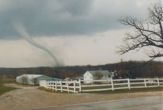Tornado Record Set: No Deaths Since March

A new record has been set for tornado deaths, and the news is all good.
For the first time since official records have been kept beginning in 1950, there were no tornado deaths from April through June.
Spring is typically the most active tornado season, with 61 percent of a year's twister deaths coming in April, May and June combined. The average for that period is 52 deaths a year.
While there have been a normal number of tornadoes this year, they have not been on the ground as long.
"This is truly a unique situation and one that we are very happy to report," said Dan McCarthy, NOAA Storm Prediction Center warning coordination meteorologist. "The ingredients needed in the atmosphere never really came together, preventing development of our normal springtime pattern that makes long-track tornadoes and tornado outbreaks possible during these prime months for severe weather."
Tornado weather could crop up at any time, however, and officials cautioned that tropical storms, such as those that appear headed to the U.S. coast this week, can spawn twisters.
"We are entering the prime time of year for tropical storms. We had 300 tornadoes last year during the tropical season, so be prepared, pay attention to weather forecasts and be safe," McCarthy said.
Get the world’s most fascinating discoveries delivered straight to your inbox.
The last spring for which tornado deaths approached this year's record was in 1992, when just one person died in the same April-June period.
Overall, tornado deaths have declined in recent years, thanks largely to better forecasting and improved warning systems.
The new record has some asterisks, however. There have been 665 tornadoes so far this year in the United States, a normal number according to the NOAA. And five people were killed by tornadoes this year prior to April.
Last year was a record year for tornadoes. By the end of June 964 had touched down.
Related Stories
- Tornado Basics
- Busiest Start Ever to Hurricane Season
- Fresh Twist on When, Where, Why Tornadoes Strike
- 2004: A Record Year for Tornadoes
- Top 10 Killer Tornadoes
Image Gallery
Tornado Country
Tornado Trivia
Some 800 tornadoes strike the United States every year. They ...
... create Earth's fastest winds, sometimes exceeding 300 mph.
... usually travel to the northeast.
... occur most frequently in the U.S. between 4 and 6 p.m.
... average 5 to 10 minutes on the ground.
... can stand still or move forward at 70 mph.
... can be up to a mile wide at ground level.
Robert is an independent health and science journalist and writer based in Phoenix, Arizona. He is a former editor-in-chief of Live Science with over 20 years of experience as a reporter and editor. He has worked on websites such as Space.com and Tom's Guide, and is a contributor on Medium, covering how we age and how to optimize the mind and body through time. He has a journalism degree from Humboldt State University in California.




